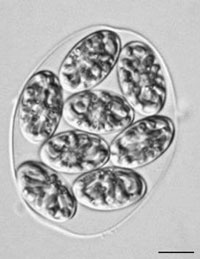Glaucophyta

FIGURE 1.28 A group of eight autospore of Glaucocystis nostochinearum still retained within parent cell wall. (Bar: 10 µm.)
Glaucophytes (Figure 1.28) are basically unicellular flagellates with a dorsiventral construction;
they bear two unequal flagella, which are inserted in a shallow depression just below the apex of
the cell. Glaucophytes are rare freshwater inhabitants, sometimes collected also from soil
samples. They posses only chlorophyll a and accessory pigments such as phycoerythrocyanin, phycocyanin,
and allophycocyanin are organized in phycobilisomes. Carotenoids such as β-carotene
and xanthophylls such as zeaxanthin are also present in their chloroplast. This unusual chloroplast
lies in a special vacuole and presents a thin peptidoglycan wall located between the two
plastid outer membranes. Thylakoids are not stacked. The chloroplast DNA is concentrated in
the center of the chloroplast, where typically carboxysomes are present,
which contain the
RuBisCo enzyme. Starch is the reserve polysaccharide, which is accumulated in granular form
inside the cytoplasm, but outside the chloroplast. Glaucophytes live photoautotrophically with
the aid of blue-green plastids often referred to as cyanelles. Cyanelles are presumed to be phylogenetically
derived from endosymbiotic cyanobacterium. Sexual reproduction is unknown in this
division.

FIGURE 1.28 A group of eight autospore of Glaucocystis nostochinearum still retained within parent cell wall. (Bar: 10 µm.)

